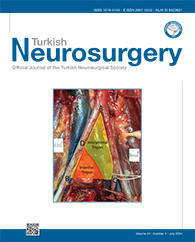2University of Sassari, G&O Clinic, Sassari, Italy
3Ospedale Di Circolo E Fondazione Macchi, Department of Neurosurgery, Varese, Italy DOI : 10.5137/1019-5149.JTN.43641-23.2 Intradiploic meningiomas are rare neoplasms, often mistaken for metastases or malignant bone tumors. Surgical management can be challenging, considering their diffusive bony invasion. Two main critical decisions need to be taken: the timing for cranial vault reconstruction and the choice of the adequate material for cranioplasty. We believe that this case underscores the complexity of such lesions, the importance of a prompt devascularization, and the pivotal role of an immediate reconstruction to avoid the additional morbidity of a re-do surgery.
Here, we report a case of 68-year-old men who presented with slow growing right parietal bone swelling he noted many years before, but for which he didn?t seek medical attentions, associated with mild contralateral hemiparesis. Neuroradiological examinations revealed a giant extradural intradiploic tumor affecting the right temporo-parietal bone and conditioning significant compression of the underlying brain. We planned a surgical strategy to deafferent the tumor and to reduce the intraoperative bleeding. At first, a circumferential craniectomy centered upon the lesion was performed, then it was devascularized by means of surgical ligation of the ipsilateral superficial temporal artery (STA) and middle meningeal artery (MMA); these steps allowed a subsequent en block tumor excision, despite its large size, without significant blood loss and respecting the oncological principles. At the end, a contextual calvarial reconstruction was performed using a precurved titanium mesh. The patient was discharged seven days after surgery with complete recovery of the left-sided motor deficit. Thereafter, he underwent scheduled outpatient evaluations and radiological examinations. At 1-year follow-up, the Modified Rankin Scale (MRS) was 1, with no evidence of recurrent disease.
To conclude, surgical complications can be reduced adopting an optimal preoperative work-up and a tailored surgical strategy focused on early tumor deafferentation. Moreover, an immediate cranial vault reconstruction avoids the risks related to a second procedure.
Keywords : Brain, Neoplasm, Intraosseus, Intradiploic, Meningioma, Primary extradural meningioma




